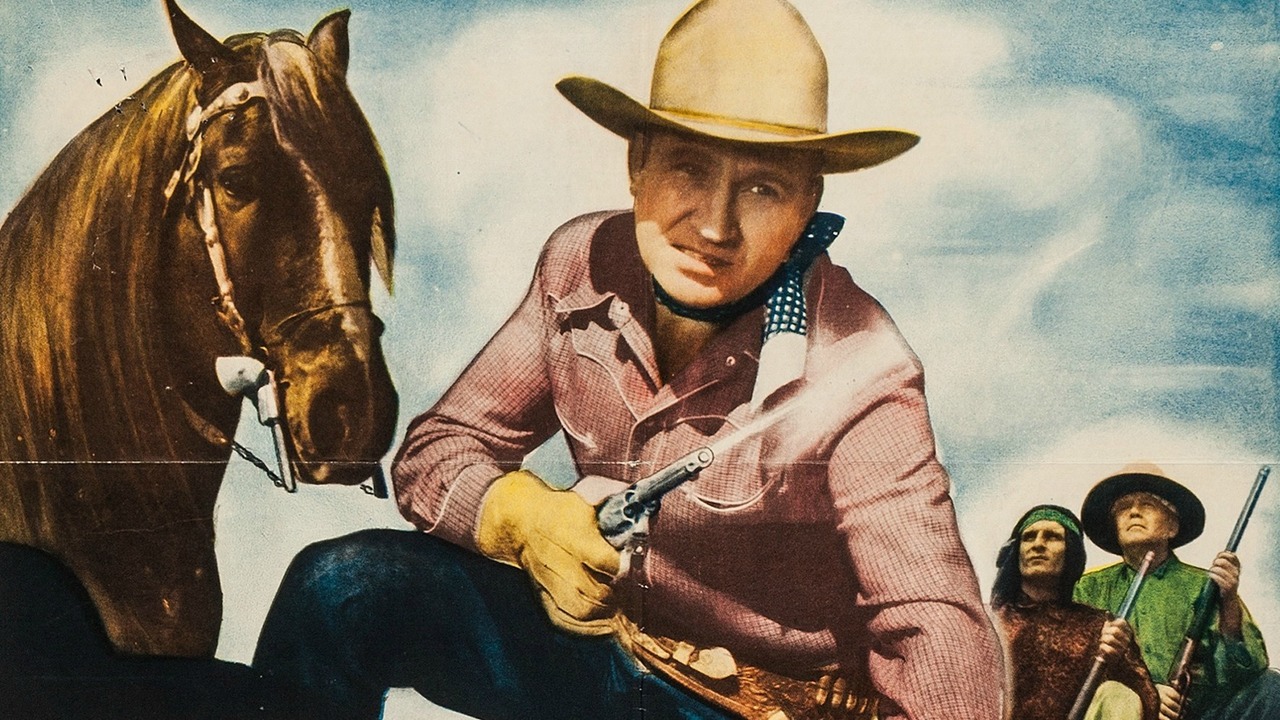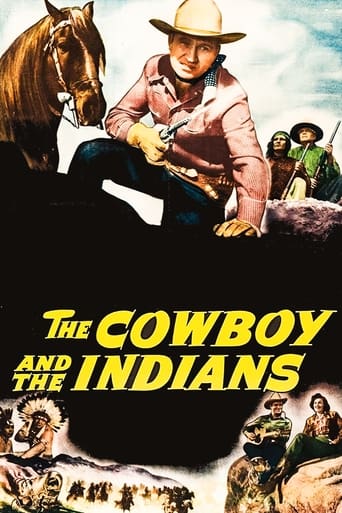Dynamixor
The performances transcend the film's tropes, grounding it in characters that feel more complete than this subgenre often produces.
Sharkflei
Your blood may run cold, but you now find yourself pinioned to the story.
Brenda
The plot isn't so bad, but the pace of storytelling is too slow which makes people bored. Certain moments are so obvious and unnecessary for the main plot. I would've fast-forwarded those moments if it was an online streaming. The ending looks like implying a sequel, not sure if this movie will get one
Skyler
Great movie. Not sure what people expected but I found it highly entertaining.
dougdoepke
Superior Autry, with lots of hard-riding, fast-shooting, and flying-fists, along with a good storyline not often seen in those days. The voice-over prologue actually explains why Indians were often hostile to the white settlers, something not often done, since their exotic looks served as useful movie canon fodder. Anyhow, the Indians are portrayed here as ordinary human beings, with a different culture but with the same needs. Then too, except for Lucy Broken Arm (Drake), real Indians are cast in leading parts, something else Hollywood did not often do.Trouble is a slippery white merchant is cheating his red man customers, such that they're having to steal food, which brings rancher Gene into the picture. Catch the great staging around the rock spires and boulders. They make a great backdrop for shootouts, and I don't think that setting was the picturesque Alabama Hills so familiar from many Hollywood oaters. Anyway, the emphasis here is on action, a humane message, and a dollop of charm (the kids) making this an unusually well-rounded Autry entry.
dodswrth
One of the interesting things about the picture is that Jay Silverheels plays a WW2 vet (Lakohna) living on the reservation and Clayton Moore is one of the thugs who is sent by the local thief/merchant to rob the Navahos. He steals and kills some sheep, and then mugs a chief for a squash blossom necklace. He and Autry do most of the fighting in the film.The kicker is, the movie, and the premier episode of The Lone Ranger, both arrived on Sept 15, 1949.An interesting moment comes when Autry sees Lakohna's medal and asks, "Guadacanal?" to which Silverheels replies, "Iwo Jima."
bozey45
A couple of comments about this film and the lack of a sidekick. Smiley Burnette, although with Columbia at this time could not be used because of still being under contract for the Charles Starrett Durango Kid series as HIS sidekick. Pat Buttram had done an introductory appearance in the Autry film "The Strawberry Roan." He did not start as Autry's sidekick until the film "Riders in the Sky" in 1950. There were several films between Roan and Riders where Autry had no sidekick. Of course, WWII was the reason Burnette signed a long contract for the Durango Kid films with Starrett, Autry having reported for duty in the war. Buttram started on Aurtry's radio show "Melody Ranch" right after the war but apparently was reluctant about appearing in films right away. I think we're all glad he did decide to do so finally and happy that Autry's last 6 films were with original sidekick Smiley Burnette in 1953.
hungadunga2001
I was a bit angered when I read the first User Comment written here by KDWms in April of 2003, and for several reasons. Sure, he or she is entitled to their opinion, and I would never dispute that. And he/she was right about several things in the film. But some of the "facts" listed in that User Comment are just plain wrong. Plus, that writer doesn't seem to know much about the real Gene Autry or the conditions that inspired this movie.I will be using a few of the statements of KDWms in this User Comment. Those words will appear in single quotes(') as I attempt to set the record straight.1. '...this flick contains BOTH Clayton Moore (as a bad guy) AND Jay Silverheels (as a college-educated Indian) BEFORE they were The Lone Ranger and Tonto.'WRONG! If KDWms had bothered to check the facts, he/she would have discovered that the first airing of "The Lone Ranger" Episode #1 and the theatrical release of Autry's "The Cowboy And The Indians" happened ON THE VERY SAME DAY - September 15, 1949. This was an easy one to check - listings for both of them appear right here on IMDb.com. He/she was right about the characters they played in this film. After seeing The Lone Ranger for years, Jay Silverheels' performance here is quite striking. He played his character, a man with an engineering degree and a decorated former GI, with no trace of a "Hollywood" Indian accent - none of that phony "Keemosabe" stuff here.2. '...this film must have been released near Christmas 'cause - get ready for a couple of song-standards of that season toward it's end.'WRONG AGAIN!! Check that September release date one more time. The song, "Here Comes Santa Claus", featured toward the end of the film, was a certified platinum hit record for Gene Autry two years earlier - in 1947 - NOT in 1949 when this film was released. Come on, KDWms. Do your homework.3. 'Aha!!! I know what's missing: the sidekick. Minimal comic relief.'Okay. If that's what you're after, that's fine - there was indeed no Smiley Burnette or Pat Buttram in this film, which there could easily have been. After all, though the picture was distributed by Columbia, it was produced by Gene Autry Productions, so Gene could have done anything he wanted with it. He did just that, including the minimum of comic relief and lack of a sidekick. And unlike most "Cowboys and Indians"-type Westerns, it's not the Cavalry that rides to the rescue in the nick of time - it's the Indians! But I believe Gene wanted to make a point with this film. Come to think of it, you seldom see marauding bands of "wild" Indians in any Gene Autry movie. Not never, but seldom.My guess is there is an important reason there's not much comic relief in this film, unlike any of the Autry films which co-starred either Burnette or Buttram. The truth behind this fictional story is not the least bit funny. Native Americans WERE starving on the reservation in 1949, and many still are today. This concerned Gene Autry greatly during his lifetime. The REAL Autry, as well as the movie Autry, was always concerned about Native American history, poverty and other issues. Notice too, that in his other films and his TV show, Autry included people of ALL races and generally treated them as equals, which was unusual in any Hollywood movie of the period. And the Bosses of the Bad Guys were white in Autry movies. Autry wasn't afraid to put his money where his mouth was. His concerns that people should know the real history of the West were why he sold his extremely profitable Los Angeles TV station, KTLA, in 1981 in order to raise the money to build The Autry Museum of Western Heritage. It was never a shrine to Autry movies nor was it intended to be. Instead it is dedicated to REAL Western history, and is now called The Museum Of The American West. The Autry National Center, the Museum's parent organization, now operates three entities: The Museum Of The American West, The Institute for the Study of the American West and The Southwest Museum of The American Indian, all located in the Los Angeles area. You can learn more about the museums at www.GeneAutry.com. Gene wanted people to learn about the history of Cowboys, settlers and Indians...the REAL way they lived, and not as they were portrayed in standard Hollywood fare. Hence the exploitation of the Native American people depicted in "The Cowboy And The Indians", which is not the sort of thing you'd see in any movie made in 1949, and in only a few since. Now that you know the truth, the next time you see "The Cowboy And The Indians", you just might cry. And it's why I would call this one of Gene Autry's better films, and anything but 'substandard'.

